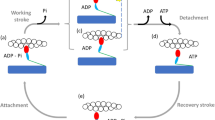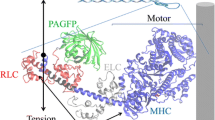Abstract
We describe an approach that allows us to form a micro in vitro motility assay with as little myosin as can be retrieved from a short ( ∼ 10 mm) segment of a single skinned skeletal muscle fiber (diameter some 100 μm). Myosin is directly extracted from the single fiber segment by a high ionic strength solution in the presence of MgATP, and the extracted myosin is immediately applied to a miniaturized flow cell that has been pretreated with BSA. The observed sliding velocities of fluorescently labeled F-actin are essentially identical with those reported in the literature. Since at the single fiber level most muscle fibers contain only a single myosin heavy chain isoform this approach allows us to determine without additional purification steps, the sliding velocity driven by myosins with different heavy chain isoforms. In addition, this approach can be used to directly correlate under identical experimental conditions unloaded shortening velocity measured in segments of skinned muscle fibers with the in vitro sliding velocity of fluorescently labeled F-actin by extraction of myosin from the same skinned fibers. Such direct correlation was performed with different myosin heavy chain isoforms as well as at different temperatures and ionic strengths. Under all conditions studied, unloaded shortening velocity was 4- to 8-fold faster than sliding velocity in the motility assay even at high temperature (22∘ C) and ionic strengths >50 mM. This suggests that sliding velocity in the motility assay is limited by additional factors beyond those thought to limit velocity of unloaded shortening in muscle fibers. One such factor might be unspecific ionic interactions between F-actin and the substrate in the motility assay resulting in somewhat higher sensitivity for ionic strength of sliding velocity in the motility assay. This might become of special relevance when using in vitro sliding velocity in assessing functional consequences of mutations involving charged residues of actin or myosin.
Similar content being viewed by others
References
Aigner S, Gohlsch B, Hämäläinen N, Staron RS, Uber A, Wehrle U and Pette D (1993) Fast myosin heavy chain diversity in skeletal muscle of rabbit: heavy chain IId, not IIb predominates. Eur J Biochem 211: 367-372.
Anson M (1992) Temperature dependence and Arrhenius activation energy of F-actin velocity generated in vitro by skeletal myosin. J Mol Biol 244: 1029-1038.
Anson M, Geeves MA, Kurzawa SE and Manstein DJ (1996) Myosin motors with artificial lever arms. EMBO J 15: 6069-6074.
Brenner B (1983) Technique for stabilizing the striation pattern in maximally calcium-activated skinned rabbit psoas fibers. Biophys J 41: 99-102.
Bukatina AE, Fuchs F and Watkins SC (1996) A study of the mechanism of phalloidin-induced tension changes in skinned rabbit psoas muscle fibres. J Muscle Res Cell Motil 17: 365-371.
Cuda G, Fananapazir L, Zhu W-S, Sellers JR and Epstein ND (1993) Skeletal muscle expression and abnormal function of b-myosin in hypertrophic cardiomyopathy. J Clin Invest 91: 2861-2865.
Cuda G, Fananapazir L, Epstein ND and Sellers JR (1997) The in vitro motility activity of b-myosin depends on the nature of the b-myosin heavy chain gene mutation in hypertrophic cardio-myopathy. J Muscle Res Cell Motil 18: 275-283.
Cuda G, Pate E, Cooke R and Sellers JR (1997) In vitro actin filament sliding velocities produced by mixtures of different types of myosin. Biophys J 72: 1767-1779.
Finer JT, Simmons RM and Spudich JA (1994) Single myosin mechanics: piconewton forces and nanometre steps. Nature (Lond.) 368: 113-119.
Fraser IDC and Marston SB (1995) In vitro motility analysis of actin-tropomyosin regulation by troponin and calcium. The thin filament is switched as a single cooperative unit. J Biol Chem 270: 7836-7841.
Harada Y, Sakurada K, Aoki T, Thomas DD and Yanagida T (1990) Mechanochemical coupling in actomyosin energy transduction studied by in vitro movement assay. J Mol Biol 216: 49-68.
Harridge SDR, Botinelli R, Canepari M, Pellegrino MA, Reggiani C, Esbjörnsson M and Saltin B (1996) Whole-muscle and single-fibre contractile properties and myosin heavy chain isoforms in humans. Eur J Physiol 432: 913-920.
Hasselbach W and Schneider G (1951) Der L-Myosin und Aktingehalt des Kaninchenmuskels. Biochem Zeitschrift 321: 462-475.
Heukeshoven J and Dernick R (1985) Simplified method for silver staining of proteins in polyacrylamide gels and the mechanism of silver staining. Electrophoresis 6: 103-112.
Hill AV (1970) First and last experiments in muscle mechanics. University Press, Cambridge.
Homsher E, Wang F and Sellers JR (1992) Factors affecting movement of F-actin filaments propelled by skeletal muscle heavy meromy-osin. J Physiol 262: C714-C723.
Homsher E, Wang F and Sellers JR (1993) Factors affecting filament velocity in in vitro motility assay and their relation to unloaded shortening velocity in muscle fibers. In: Sugi H and Pollack GH (eds.) Mechanism of Myofilament sliding in muscle contraction. pp. 279-289, Plenum, New York.
Huxley AF (1957) Muscle structure and theories of contraction. Prog Biophys Biophys Chem 7: 255-318.
Ishijima A, Doi T, Sakurada Kand Yanagida T (1991) Sub-piconewton force fluctuations of actomyosin in vitro. Nature 352: 301-306.
Ishijima A, Harada Y, Kojima H, Funatsu T, Higuchi H and Yanagida T (1994) Single-molecule analysis of the actomyosin motor using nano-manipulation. Biochem Biophys Res Commun 199: 1057-1063.
Ishijima A, Kojima H, Higuchi H, Harada Y, Funatsu T and Yanagida T (1996) Multiple-and single-molecule analysis of the actomyosin motor by nanometer-piconewton manipulation with a microneedle: unitary steps and forces. Biophys J 70: 383-400.
Julian FJ, Sollins MR and Moss RL (1978) Sarcomere length non-uniformity in relation to tetanic responses of stretched skeletal muscle fibers. Proc R Soc London Ser B 200: 109-116.
Kielley WW and Harrington WF (1960) A model for the myosin molecule. Biochem Biophys Acta 41: 401-421.
Kishino A and Yanagida T (1988) Force measurements by microma-nipulation of a single actin filament by glass needles. Nature 334: 74-76.
Kraft T, Becker F, Regel G and Brenner B (1995a) Cross-bridge kinetics in single fibers of human soleus muscle. Biophys J 68: 72a.
Kraft T, Chalovich JM, Yu LC and Brenner B (1995b) Parallel inhibition of active force and relaxed fiber stiffness by caldesmon fragments at physiological ionic strength and temperature condi-tions: additional evidence that weak cross-bridge binding to actin is an essential intermediate for force generation. Biophys J 68: 2404-2418.
Kraft T, Messerli M, Rothen-Rutishauser B, Perriard J-C, Wallimann T and Brenner B (1995c) Equilibration and exchange of fluores-cently labeled molecules in skinned skeletal muscle fibers visualized by confocal microscopy. Biophys J 69: 1246-1258.
Kron SJ and Spudich JA (1986) Fluorescent actin filaments move on myosin fixed to a glass surface. Proc Natl Acad Sci USA 83: 6272-6276.
Kron SJ, Toyoshima YY, Uyeda TQP and Spudich JA (1991) Assays for actin sliding movement over myosin-coated surfaces. Methods Enzymol 196: 399-416.
Kubis H-P and Gros G (1997) A rapid electrophoretic method for separating rabbit skeletal muscle myosin heavy chain at high resolution. Electrophoresis 18: 64-66.
Larsson L and Moss R (1993) Maximum velocity of shortening in relation to myosin isoform composition in single fibres from human skeletal muscle. J Physiol (Lond) 472: 595-614.
Lorenz M, Poole KJV, Popp D, Rosenbaum G and Holmes KC (1995) An atomic model of the unregulated thin filament obtained by X-ray fiber diffraction on oriented actin-tropomyosin gels. J Mol Biol 246: 108-119.
Metzger JM (1996) Effects of phosphate and ADP on shortening velocity during maximal and submaximal calcium activation of the thin filament in skeletal muscle fibers. Biophys J 70: 409-417.
Molloy JE, Burns JE, Kendrick-Jones J, Tregear RT and White DCS (1995) Movement and force produced by a single myosin head. Nature 378: 209-212.
Moss RL (1986) Effects on shortening velocity of rabbit skeletal muscle due to variations in the level of thin-filament activation. J Physiol (Lond) 377: 487-505.
Pardee JD and Spudich JA (1982) Purification of muscle actin. Methods in Enzymol 85: 164-181.
Ruppel KM, Uyeda TQ and Spudich JA (1994) Role of highly conserved lysine 130 of myosin motor domain. In vivo and in vitro characterization of site specifically mutated myosin. J Biol Chem 269: 18773-18780.
Sant'ana-Pereira JA, Wessels A, Nijtmans L, Moormann AF and Sargeant AJ (1995) New method for the accurate characterization of single human skeletal muscle fibres demonstrates a relation between mATPase and MyHC expression in pure and hybrid fibre types. J Muscle Res Cell Motil 16: 21-34.
Sellers JR, Spudich JA and Sheetz MP (1985) Light chain phosphor-ylation regulates the movement of smooth muscle on actin filaments. J Cell Biol 101: 1897-1902.
Sellers JR and Kachar B (1990) Polarity and velocity of sliding filaments: control of direction by actin and of speed by myosin. Science 249: 406-408.
Sellers JR, Cuda G, Wang F and Homsher E (1993) Myosin-specific adaptations of motility assay. Methods Cell Biol 39: 23-49.
Sheetz MP and Spudich JA (1983) Movement of myosin-coated fluorescent beads on actin cables in vitro. Nature (Lond) 303: 31-35.
Sheetz MP, Chasan R and Spudich JA (1984) ATP-dependent movement of myosin in vitro: characterization of a quantitative assay. J Cell Biol 99: 1867-1871.
Sheetz MP, Block SM and Spudich JA (1986) Myosin movement in vitro: a quantitative assay using oriented actin cables from Nitella. Methods Enzymol 134: 531-544.
Sutoh K (1993) Identification of actin surface interacting with myosin during the actin-myosin sliding. Adv Exp Med Biol 332: 241-244.
Sutoh K, Ando M, Sutoh K and Toyoshima Y (1991) Site-directed mutations of Dictyostelium actin: disruption of a negative charge cluster at the N-terminus. Proc Natl Acad Sci USA 88: 7711-7714.
Tawada K and Sekimoto K (1991) A physical model of ATP-induced actin-myosin movement in vitro. Biophys J 59: 343-356.
Thedinga E and Brenner B (1995) In vitro motility assay with myosin isolated from a single skinned muscle fibre. JMuscle Res Cell Motil 16: 460.
Thedinga E, Kraft T and Brenner B (1996) A single fiber In vitro motility assay. Biophys J 70: A41.
Toyoshima YY, Kron SJ and Spudich JA (1990) The myosin step size: measurement of the unit displacement per ATP hydrolyzed in an in vitro assay. Proc Natl Acad Sci USA 87: 7130-7134.
Uyeda TQP, Warrick HM, Kron SJ and Spudich JA (1991) Quantized velocities at low myosin densities in an in vitro motility assay. Nature 352: 307-311.
Uyeda TQP, Ruppel KM and Spudich JA (1994) Enzymatic activities correlate with chimeric substitutions at the actin-binding face of myosin. Nature 368: 567-569.
Uyeda TQP, Abramson PD and Spudich JA (1996) The neck region of the myosin motor domain acts as a lever arm to generate movement. Proc Natl Acad Sci USA 93: 4459-4464.
Warshaw DM, Desrosiers JM, Work SS and Trybus KM (1990) Smooth muscle myosin cross-bridge interactions modulate actin filament sliding velocity in vitro. J Cell Biol 111: 453-463.
Winkelmann DA, Bourdieu L, Ott A, Kinose F and Libchaber A (1995) Flexibility of myosin attachment to surfaces in¯uences F-actin motion. Biophys J 68: 2444-2453.
Yanagida T, Nakase M, Nishiyama K and Oosawa F (1984) Direct observation of motion of single F-actin filaments in the presence of myosin. Nature 307: 58-60.
Yu LC and Brenner B (1989) Structures of actomyosin crossbridges in relaxed and rigor muscle fibers. Biophys J 55: 441-453.
Author information
Authors and Affiliations
Rights and permissions
About this article
Cite this article
Thedinga, E., Karim, N., Kraft, T. et al. A single-fiber in vitro motility assay. In vitro sliding velocity of F-actin vs. unloaded shortening velocity in skinned muscle fibers. J Muscle Res Cell Motil 20, 785–796 (1999). https://doi.org/10.1023/A:1005658825375
Issue Date:
DOI: https://doi.org/10.1023/A:1005658825375




